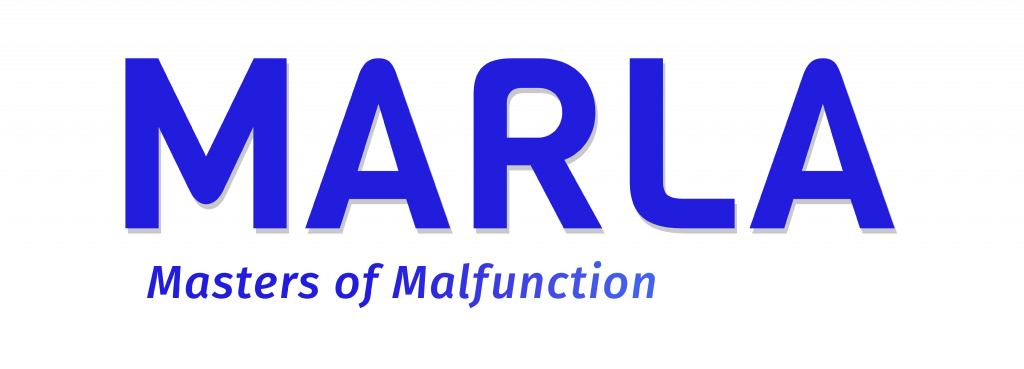
About the Game
“MARLA: Masters of Malfunction” is an award-winning educational game that trains troubleshooting for mechanical, electrical, and hydraulic errors. Developed for use in vocational school lessons by trainees in metal and electrical engineering. Trainees learn how to maintain and repair an offshore wind turbine – directly in the classroom.
The research project was funded by the Federal Ministry of Education and Research and developed in cooperation with the TU Berlin, the Handwerkskammer Koblenz as well as the Handwerkskammer Osnabrück-Emsland-Grafschaft Bentheim.
Factsheet
Platform
Meta Quest
Genre
VR Educational Game
Release
2022
Studio
the Good Evil GmbH
Role and Responsibilities
- Researching and adapting the environments of an offshore wind turbine to the requirements of VR locomotion & interaction, creating a visual language to communicate complex technical concepts
- Creating, testing and iterating blockouts for the different environments
- Setting up and scripting basic interactions with the environment and NPC instructor, writing dialogues
- Set dressing the levels, implementing feedback from remote playtests with the target group
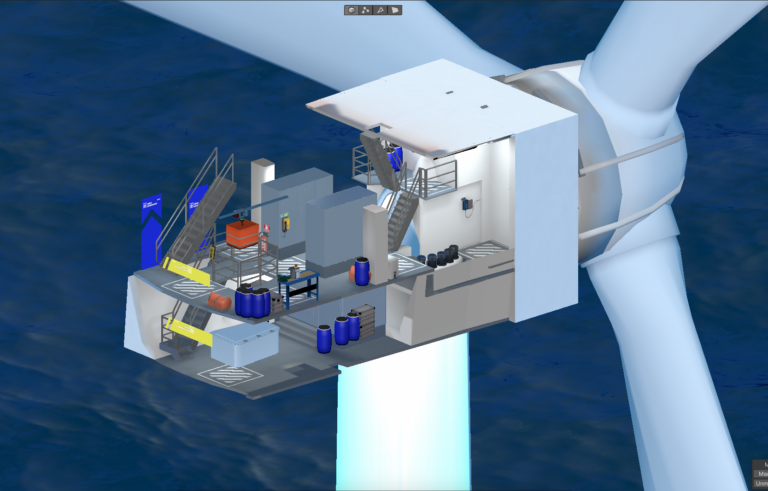
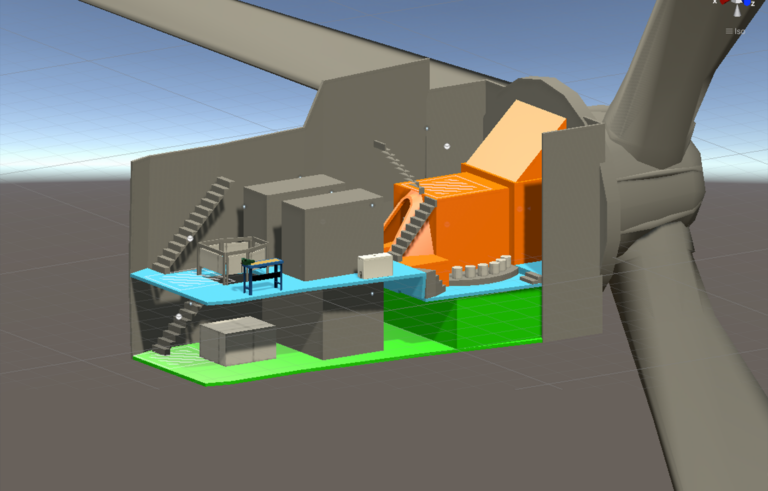
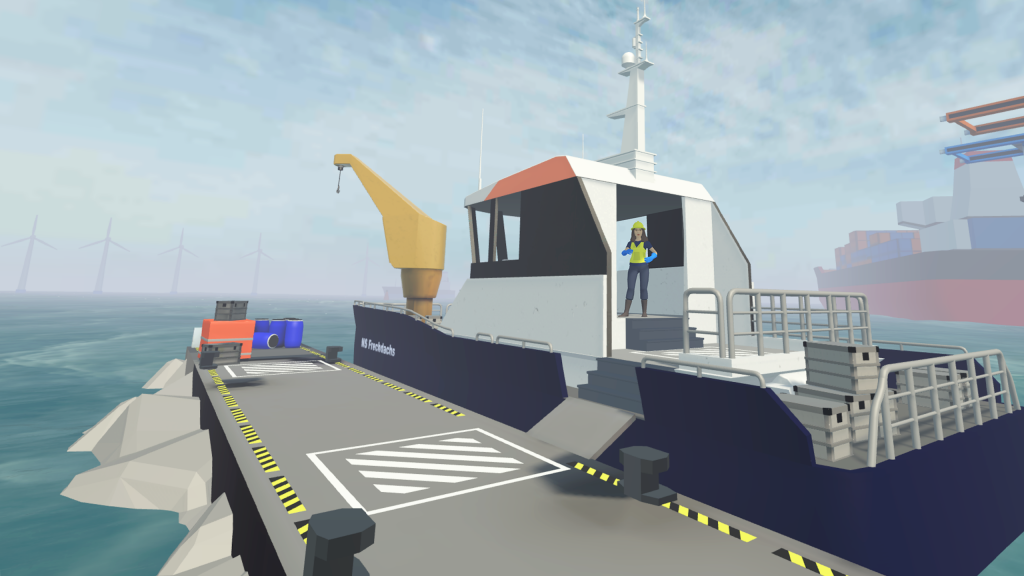
Contributions
As the Level Designer of the project, I was responsible for bringing the interiors and exteriors of the offshore wind turbine into Virtual Reality. This includes balancing alterations to the model in favor of the player experience with the requirement to represent an environment that is as true to reality as possible. I worked closely with the art department and in constant exchange with our experts from the fields of psychology and didactics to create a consistent visual language and ensure the environments supports the learning goals.
Level Design considerations for VR serious games
I usually start my level design process by gathering as many references to a location as I can, this already proved to be difficult for the spaces in MARLA as offshore wind turbines (especially their interiors) are in fact neither often the setting for games nor any other visual media. And since big energy companies seem to prefer to keep to themself, there are also not as many actual pictures of them that can be found online.
Fortunately, our project partners from the field provided us with, even if only a few, photos and some vague metrics of the plant. Equipped with these I started recreating the interior of the nacelle in Unity from simple shapes. At the same time, I worked with the programmers on assembling a “Player Zoo”, a scene where we tested and showcased all things from locomotion or simple collision to complex mechanics. Here we also defined the size of the playspace in which the player could freely move.
In MARLA we choose “Zone-based-teleportation” for locomotion, which means that players can move freely within a predefined area by actually walking, and only move beyond its bounds by teleporting from one of these playspaces to another. After the teleport, their relative position within the space stays the same as before the teleport. We made this decision early in development after having tested all common means of locomotion in VR as we found that it encourages physical movement over teleporting everywhere as with other locomotion solutions. Actual walking is more intuitive, less motion sickness inducing, and a more engaging way to interact with the virtual space.
There are of cause also really good use cases for direct teleportation, for example when players don’t have a lot of real-life space to play in, when games have a long playtime and standing up becomes tiring, or when the game requires a lot of vertical traversal. MARLA is meant to be played in a classroom setting, therefore space (while not totally abundant) wasn’t an issue.
With the rough blockout of the nacelle finished and the playspace size defined, I started iterating the space. I determined in close collaboration with our experts which of the areas in the nacelle needed to be most accessible for the repairs and made sure that the gap between two playspaces was small enough that the “jump” would not feel too huge.
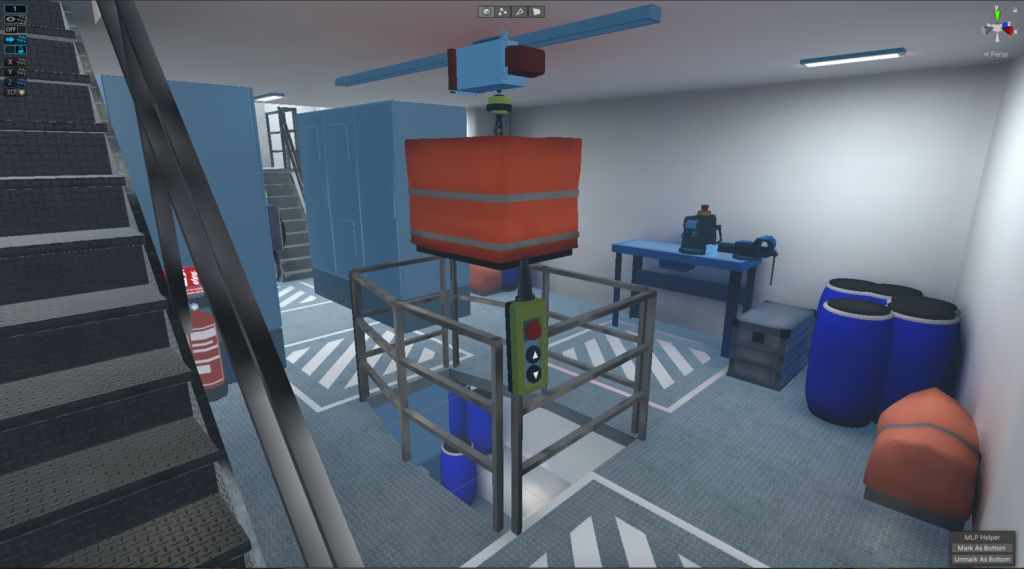
My goal was to make sure that players could still explore the space but keep the number of “empty” playspaces (those just used as a “bridge” to another space with gameplay) to a minimum.
Moreover, it was quite challenging to widen up the tight corridors and chambers of the plant to make room for the playspaces while also trying to keep as close to the real-life counterpart as possible. After all, MARLA being a Serious Game meant straying too far from it might forfeit the game’s learning goals.
The layout and different premises of an offshore wind turbine are for most people unknown territory. For a lot of ordinary places like offices, schools, churches, or stores, for example, people have developed a rough mental map based on real-world knowledge that they can refer to when navigating similar spaces in games. Additionally, the interiors of the plant don’t offer many reference points. Looking out of one of the few windows presents players only with a view of the open sea and other carbon copies of the wind turbine they are currently standing on.
The players of MARLA, therefore, where in need for additional aid to better navigate the game.
To ensure smooth and fast traversal between spaces, we made use of the following means:
- Simplifying the overall layout of the plant by only letting the player into spaces needed for the playthrough
- Introducing the rough layout of the plant early on in the game and confronting the players repeatedly with 3D visualizations of the space
- Adding additional signage to the walls to indicate the player’s current position and its relation to neighboring spaces
- Linking certain places to specific mechanics (“Aha, I remember that’s the place where I can measure the pressure!”)
- Giving important places & objects more detail and color to create a higher contrast to the rest of the environment
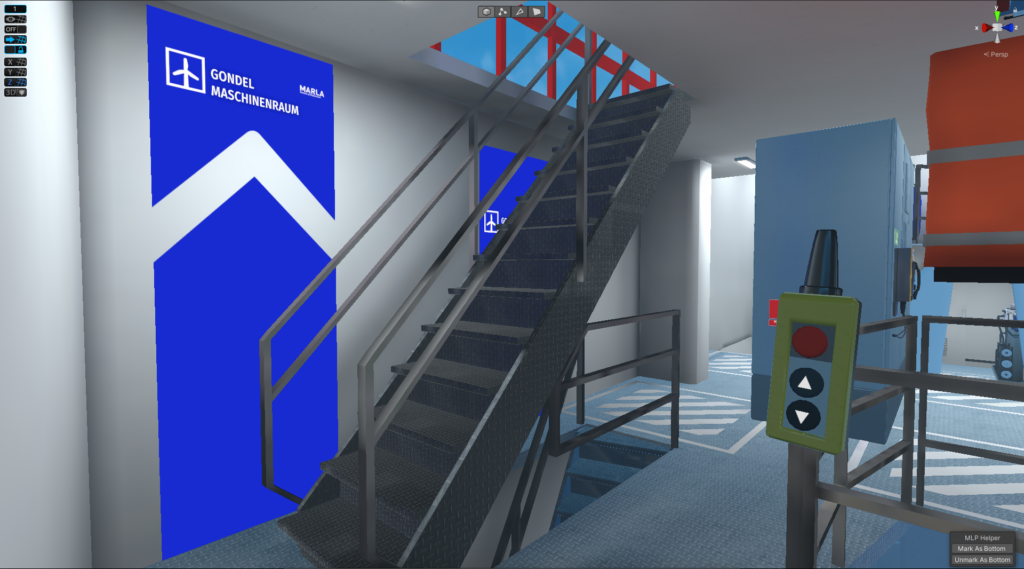
The most helpful and straightforward tool we had players provided with after all was an interactive 3D map of the wind turbine that shows them their location at the touch of a button and teleports them to any other part of the turbine.
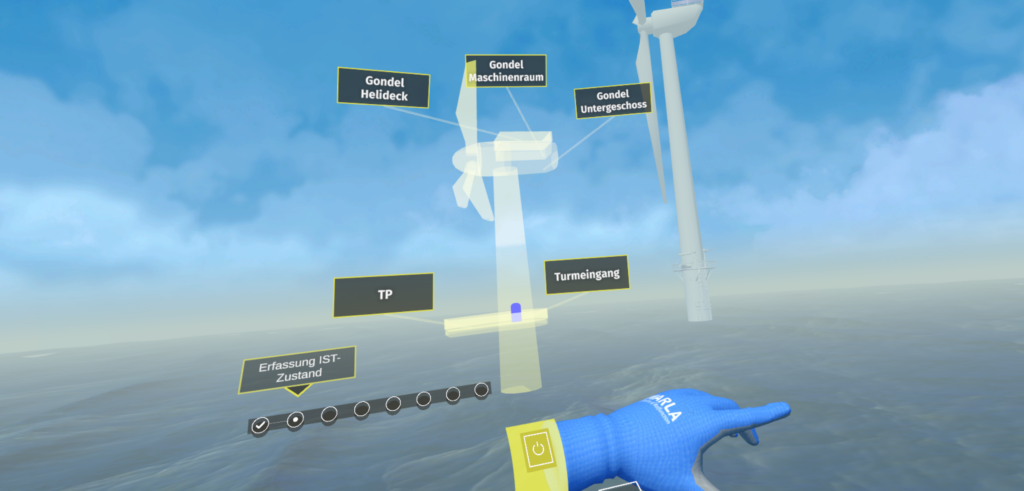
These means not only simplified the experience for players and allowed them to focus more on other challenges, but also helped to achieve a secondary learning objective of gaining a better understanding of the overall location.
The spatial immersion, as well as the intuitive interaction in VR, can be two significant advantages for Serious games over screen-based games. Tilting your head to move the camera or actually reaching for objects instead of moving an analog stick comes easy to players, especially those with no prior game literacy. For MARLA we wanted to stick with these advantages and therefore tried to keep more abstract inputs to a minimum. Players can interact with their environment mostly by touching or grabbing, using only the motion-tracked controllers and one button at a time.
In the context of the game’s setting, this also meant simplifying many of the complicated motion required for repairing a wind turbine. When discussing the topic with our partners at the project, I explained to them that the way to think about interaction in VR is like working while wearing oven gloves. Levers, buttons, or tools need to be roughly 20% bigger to be used without issues.
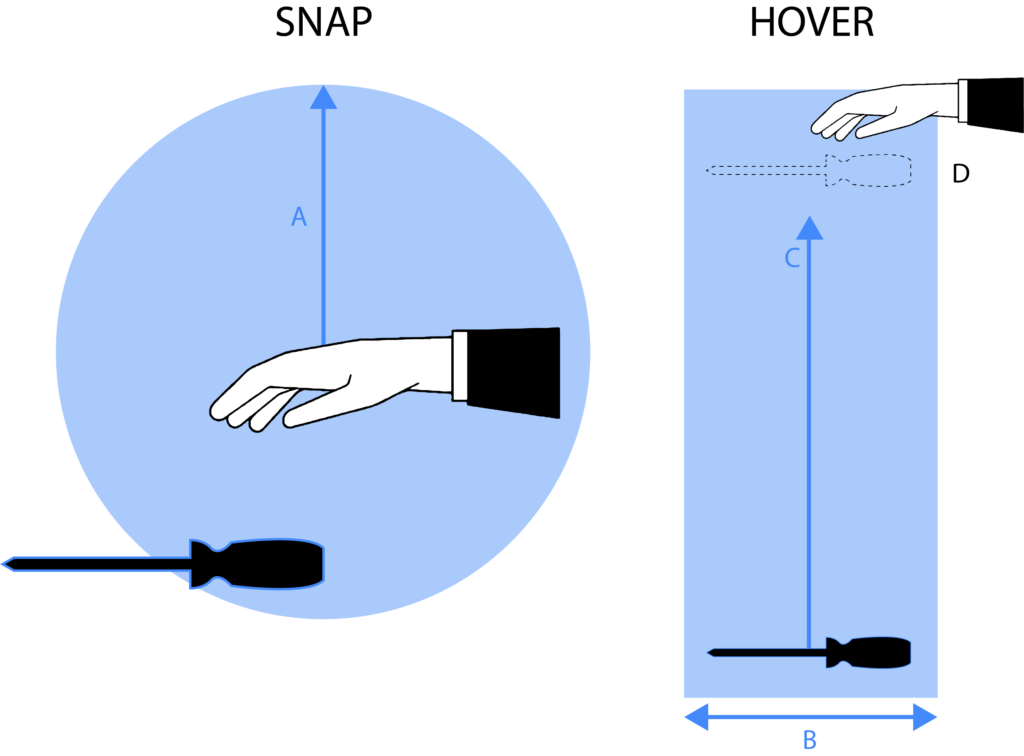
Additionally, in particular, two features helped us with making interactions with objects like tools more accessible:
Snap – While the tracking of the Oculus controllers is very precise, we still wanted to make sure that grabbing is as easy for the players as it can be. Especially since touching and grabbing objects and tools is one of the most common means of interaction in VR. Whenever a player in MARLA brings their controller close to a tool, it will be highlighted in a bright yellow. Highlighted objects can be grabbed without the need for making precise contact with them, they simply get snapped into the player’s hands.
Hover – Depending on where a pickable object is located, players may not be able to reach it comfortably. Repeatedly squatting or bending down to grab a screwdriver or a dropped sensor can become a problem, especially when the ground isn’t correctly tracked by the HMD. That’s why we added a feature where players can simply hold their hand over the desired object to levitate it to a height where they can easily grab it.
Here are some of the games that inspired us and we often look to when thinking about design solutions for MARLA:
- “I Expect You To Die” by Schell Games
- “Keep Talking and Nobody Explodes” by Steel Crate Games
- “Vacation Simulator” & “Rick and Morty Simulator: Virtual Rick-ality” by Owlchemy Labs
- “Half-Life: Alyx” by Valve Corporation
These are a selected few talks and videos that I repeatedly referred to when designing environments and interactions in MARLA. Especially the GDC talks by the folks from Owlchemy Labs are a treasure trove of knowledge.
“Maximizing the feeling of Comfort in VR by Minimizing Fatigue” by Thorsten Leimann
https://youtu.be/wSIyw_etAao?t=76
“Job Simulator to Vacation Simulator: Advanced Interactions for Room-Scale VR” by Owlchemy Labs’ Devin Reimer and Andrew Eiche
https://youtu.be/q83f3sdQBBc
“Rick and Morty: Virtual Rick-ality Postmortem: VR Lessons *Burrrp* Learned” by Owlchemy Labs’ Alex Schwartz and Devin Reimer
https://youtu.be/LMbx_PxXZAE
“Medal of Honor: Above and Beyond – “Inside Scuttle” Designer Chatter” by Alexa Kim
https://youtu.be/tRw5ymgkqqg

